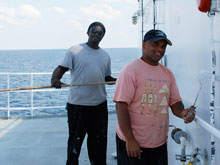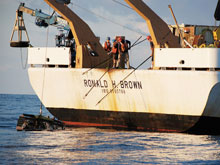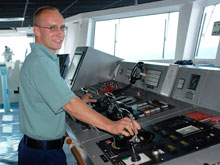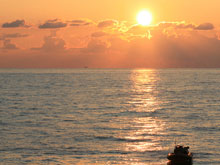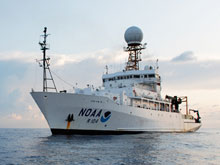
The NOAA ship Ronald H. Brown in the Gulf of Mexico. Click image for larger view and image credit.
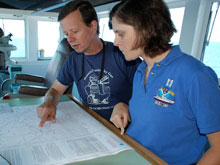
Operations officer Lt. Nicole Manning confers with Chief Scientist Chuck Fisher about the next day’s dive plan. Click image for larger view and image credit.
Careers Onboard a Research Vessel
August 27, 2009
Lt. Nicole Manning
Operations Officer
NOAA
My name is Lieutenant Nicole Manning; I am the operations officer on the NOAA research vessel Ronald H. Brown. My job is super fantastic because I get to provide logistical support to the science party. I help coordinate all operational activities for the scientists, including pre-cruise planning, post-cruise logistics, staging the scientific equipment, and daily operations.
My interest in ocean science began in high school, when I was a part of the University of Hawaii and the Waikiki Aquarium’s Blue Water Marine Lab, a popular oceanography program which gives high school students hands-on training in marine science. I subsequently earned an undergraduate degree in biology and worked as a molecular biologist at the National Institutes of Health in Bethesda, Maryland. I became an ensign in the NOAA Commissioned Officer Corps ![]() in 2002 primarily because I was told that I would learn to drive a ship — and boy, they weren’t kidding!
in 2002 primarily because I was told that I would learn to drive a ship — and boy, they weren’t kidding!
On the Brown, I get to drive and navigate the ship in accordance with the cruise plan provided by the chief scientist. With the Brown's substantial maneuverability and dynamic positioning system, the corps officers and licensed mate who operate the Brown are able to hold station and maneuver this 274-foot ship with ease, which is very important when launching and recovering the remotely operated vehicle (ROV) Jason.
Since its commissioning 12 years ago, the Brown has sailed around the world, participating in scientific operations in three oceans and making port calls on six continents. With a vast array of oceanographic and atmospheric data logging equipment, the Brown is one of the most sophisticated ocean observing platforms in the world.
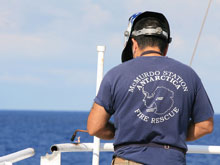
Gordon Gardipe, 2nd assistant engineer, fabricates a handrail on the 02 forward deck. Click image for larger view and image credit.
Commissioned Officers and Wage Marine Personnel
Maintaining a world-class vessel with such a diverse mission requires a highly skilled and well-trained crew consisting of a cadre of talented individuals. The ship regularly operates with a crew of 27 personnel, which includes a combination of NOAA Commissioned Officer Corps ![]() and wage marine personnel. The wage marine personnel are civilian mariners who are sometimes trained in maritime institutions (see Maritime Administration/Education
and wage marine personnel. The wage marine personnel are civilian mariners who are sometimes trained in maritime institutions (see Maritime Administration/Education ![]()
![]() ) and include licensed mates and engineers, and unlicensed members of the engine, steward, and deck departments. While NOAA Corps officers are recruited from the scientific community and are trained to operate ships in only 17 weeks, the civilian mariners come from a variety of backgrounds and many learn their respective jobs through years of experience on a specific ship. Some individuals start out in entry-level positions and work their way up “through the hawse pipe.” The hawse pipe is the opening through which the anchor chain runs from the deck down through the ships bow to the water’s edge. To come up through the hawse pipe is an old naval slang expression that means promotion from the lower deck.
) and include licensed mates and engineers, and unlicensed members of the engine, steward, and deck departments. While NOAA Corps officers are recruited from the scientific community and are trained to operate ships in only 17 weeks, the civilian mariners come from a variety of backgrounds and many learn their respective jobs through years of experience on a specific ship. Some individuals start out in entry-level positions and work their way up “through the hawse pipe.” The hawse pipe is the opening through which the anchor chain runs from the deck down through the ships bow to the water’s edge. To come up through the hawse pipe is an old naval slang expression that means promotion from the lower deck.
We may have all “come up through the hawse pipe” by different avenues but the one thing we all share in common is a love of adventure and a strong sense of teamwork!




























